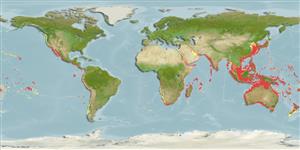Common names from other countries
Classification / Names / Names
ماع يماسا | فدارتم | Catalog of Fishes (gen., sp.) | ITIS | CoL | WoRMS
Environment: milieu / climate zone / depth range / distribution range
يسانش موب
گنس بآ هب هتسباو; قمع تارييغت 0 - 222 m (Ref. 106682). Tropical
Southeast Atlantic and entire tropical Indo-Pacific from Red Sea and South Africa to the Hawaiian Islands.
Length at first maturity / Size / Weight / نس
Maturity: Lm ? range ? - ? cm Max length : 12.0 cm WD يسنج صاوخ نودب / رن سنج; (Ref. 800)
The five arms have blunt and tapered ends that curve slightly upwards. Both oral and aboral sides are flattened, with the aboral disc being slightly convex. Body color varies from greenish-blue, to brownish-gray and dark reddish-brown. This species is characterized by its distinctive laterally projecting rows of spines on the supero-marginal plate.
Buried in the sand during daytime and crawls on the sand to search for food at night. Feeds primarily on bivalves and gastropods and other small invertebrates buried in the sand (Ref. 800).
Life cycle and mating behavior
غولب | لثم دیلوت | یزیر مخت | اه مخت | Fecundity | )ورال ( دازوت
Members of the class Asteroidea exhibit both asexual (regeneration and clonal) and sexual (gonochoric) means of reproduction. Life cycle: Embryos hatch into planktonic larvae and later metamorphose into pentamorous juveniles which develop into young sea stars with stubby arms.
یلصا ذخآم
عجارم | هدننك گنهامه | ناراكمه
Schoppe, S. 2000. (Ref. 800)
NCUI زمرق تسرهف رد تيعضو (Ref. 130435)
ستياس رظن زا تيعضو (Ref. 108899)
Not Evaluated
Not Evaluated
اه ناسنا یارب رطخ
Harmless
یناسنا هدافتسا
| FishSource |
اهرازبا
رتشيب تاعالطا
Age/Sizeدشرنزو - لوطلوط - لوطيسانش تخير)ورال ( دازوتيناوارف
يتنرتنيا عبانم
Estimates based on models
Preferred temperature
(Ref.
115969): 15.3 - 29, mean 27.4 (based on 2738 cells).
یريذپ بيسآ
Low vulnerability (10 of 100).
تميق هقبط
Unknown.
